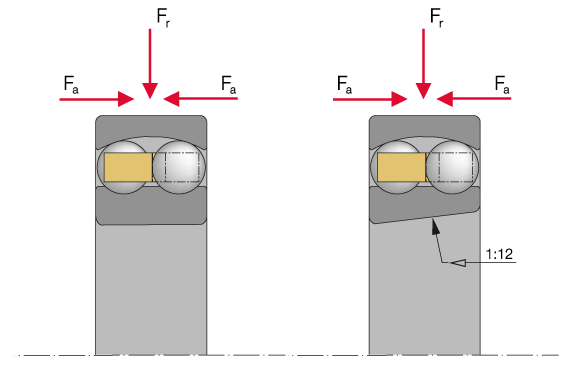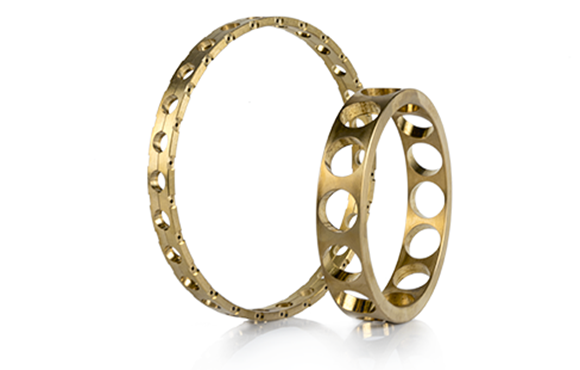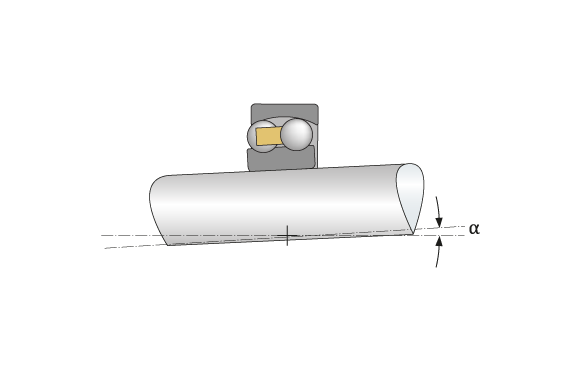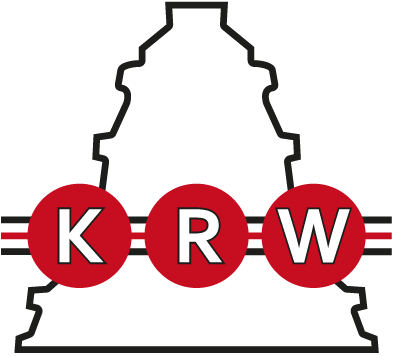
Self-aligning Ball Bearings
- Compensation of angular misalignments possible
- Absorption of radial and two-sided axial forces
- Suitable for up to medium speeds

Self-aligning ball bearings are bearings with two rows, two divided raceways on the inner ring and one shared concave raceway on the outer ring. They are particularly suitable for compensation of misalignments between shaft and housing. Self-aligning ball bearings can absorb radial and axial forces and are suitable for smooth and cool operation at increased speeds due to low friction.
Dimensions and Tolerances
KRW supplies self-aligning ball bearings with normal tolerance (PN) in accordance to DIN 620-2 (Tolerances for roller bearings) and ISO 492 (Radial bearings - Dimensional and geometrical tolerances). All other deviating or special tolerances must be specified with the order.

Types of self-aligning ball bearings
Bearing Design
Self-aligning ball bearings are self-latching bearings that cannot be disassembled. They can absorb high radial forces as well as low axial forces from both directions. The minimum load of the bearing is very low. Self-aligning ball bearings can be delivered with cylindrical or tapered bore.
Bearing Clearance
KRW supplies self-aligning ball bearings in normal clearance (CN) in accordance with DIN 620-4 (Radial internal clearance) and ISO 5753-1 (Rolling bearings - Internal clearance), but they are also available in all clearance classes with restricted clearance or special clearance.
| ||||||||

Cage
By default, self-aligning ball bearings by KRW come with a two-piece roller-riding solid brass cage (suffix: M). Other cage designs are available on request or chosen for specific applications and labeled accordingly on the bearing.
Suffixes

Compensation of angular misalignment in a self-aligning ball bearing
Compensation of Angular Misalignments
Self-aligning ball bearings are suitable for compensation of misalignments between inner and outer bearing rings due to shaft deflections, angular errors and housing deformation. The admissible angular misalignment with static and circulating inner ring differs between types. The maximal angular adjustment α is available on request.
Speed
KRW distinguishes between kinematic limiting speed nG and thermal reference speed nth. The kinematic limiting speed is a practical mechanical limit value and is based on the mechanical fatigue strength of the rolling bearing as a function of its installation situation and lubrication. The limit speed must not be exceeded even under optimum operating conditions without prior consultation with KRW.
The thermal reference speed represents the equilibrium between the heat generated in the bearing by friction and the heat flow dissipated. It is standardised in DIN ISO 15312 (Rolling bearings - Thermal reference speed).
Admissible Operating Temperatures
The admissible operating temperature of a bearing is limited by cage material, dimensional stability of the bearing components (ball race and rolling elements), as well as lubrication. By default, KRW bearings are stabilised up to 200°C (S1). KRW provides bearings for higher operating temperatures on request.
Dimensioning
For dynamically loaded bearings
The service life formula according to ISO 281 L10 = (C/P)p for dynamically loaded bearings requires an equivalent load (P) from constant direction and size. To calculate P, calculation factors and the ratio of axial and radial load are required.
Equivalent dynamic bearing load P
The equivalent bearing service life for self-aligning ball bearings depends on the ratio Fa/Fr (axial force / radial force). The equivalent dynamic bearing load can then be determined using the following formula:

| P | equivalent dynamic load | [kN] |
| Fr | dynamic radial force | [kN] |
| Fa | dynamic axial force | [kN] |
| e | calculation factor, see chart | [-] |
| Y1 | calculation factor, see chart | [-] |
| Y2 | calculation factor, see chart | [-] |
For statically loaded bearings
Dynamic dimensioning loses its validity for bearings rotating at very low speeds (n x dm ≤ 4000 mm/min). The static load safety factor S0 is calculated as follows:

| S0 | static load safety factor | [-] |
| C0 | basic static load rating (from bearing chart) | [kN] |
| P0 | equivalent static bearing load | [kN] |
| n | bearing speed | [min-1] |
| dm | mean bearing diameter [dm = (D+d)/2] | [mm] |
Static load capacity

Axial load capacity
The axial load capacity of self-aligning ball bearings is low due to the broad osculation on the outer ring.
When using self-aligning ball bearings with clamping sleeves on smooth shafts, make sure that, despite enough security, the maximum occurring axial loads are lower than the pressed connection between shaft and bearing bore. For a professional installation, the following formula can be used to estimate the admissible axial load capacity:

| Fa,zul | max. admissible axial load | [kN] |
| B | bearing width, see product chart | [mm] |
| d | bore diameter, see product chart | [mm] |
Minimum radial load
A minimum load is required for the reliable operation of a rolling bearing. If the minimum load is not reached, slippage may occur. The minimum radial load for self-algning ball bearings is roughly assumed to be 1% of the static load rating C0 of the bearing. If the value falls below this value, please consult the KRW Application Engineering department.



